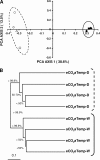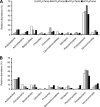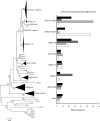Soil microbial community responses to multiple experimental climate change drivers
- PMID: 20023089
- PMCID: PMC2820983
- DOI: 10.1128/AEM.02874-09
Soil microbial community responses to multiple experimental climate change drivers
Abstract
Researchers agree that climate change factors such as rising atmospheric [CO2] and warming will likely interact to modify ecosystem properties and processes. However, the response of the microbial communities that regulate ecosystem processes is less predictable. We measured the direct and interactive effects of climatic change on soil fungal and bacterial communities (abundance and composition) in a multifactor climate change experiment that exposed a constructed old-field ecosystem to different atmospheric CO2 concentration (ambient, +300 ppm), temperature (ambient, +3 degrees C), and precipitation (wet and dry) might interact to alter soil bacterial and fungal abundance and community structure in an old-field ecosystem. We found that (i) fungal abundance increased in warmed treatments; (ii) bacterial abundance increased in warmed plots with elevated atmospheric [CO2] but decreased in warmed plots under ambient atmospheric [CO2]; (iii) the phylogenetic distribution of bacterial and fungal clones and their relative abundance varied among treatments, as indicated by changes in 16S rRNA and 28S rRNA genes; (iv) changes in precipitation altered the relative abundance of Proteobacteria and Acidobacteria, where Acidobacteria decreased with a concomitant increase in the Proteobacteria in wet relative to dry treatments; and (v) changes in precipitation altered fungal community composition, primarily through lineage specific changes within a recently discovered group known as soil clone group I. Taken together, our results indicate that climate change drivers and their interactions may cause changes in bacterial and fungal overall abundance; however, changes in precipitation tended to have a much greater effect on the community composition. These results illustrate the potential for complex community changes in terrestrial ecosystems under climate change scenarios that alter multiple factors simultaneously.
Figures



References
-
- Austin, E. E., H. F. Castro, K. E. Sides, C. W. Schadt, and A. T. Classen. 2009. Assessment of 10 years of CO2 fumigation on soil microbial communities and function in a sweetgum plantation. Soil Biol. Biochem. 41:514-520.
-
- Bakkenes, M., J. R. M. Alkemade, F. Ihle, R. Leemans, and J. B. Latour. 2002. Assessing effects of forecasted climate change on the diversity and distribution of European higher plants for 2050. Global Change Biol. 8:390-407.
-
- Bardgett, R. D., C. Freeman, and N. J. Ostle. 2008. Microbial contributions to climate change through carbon cycle feedbacks. ISME J. 2:805-814. - PubMed
Publication types
MeSH terms
Substances
LinkOut - more resources
Full Text Sources
Other Literature Sources
Medical
Molecular Biology Databases

